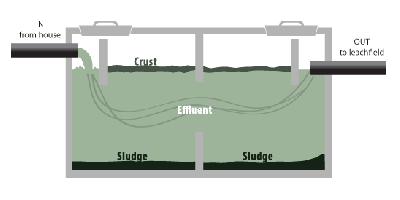|
TOP FOUR THINGS YOU CAN DO TO PROTECT YOUR SEPTIC SYSTEM
- Regularly inspect your system and pump your tank as necessary.
- Use water efficiently.
- Don’t dispose of household hazardous wastes in sinks or toilets.
- Care for your drainfield.
|
Having your septic tank pumped can be an exhausting and expensive experience if you choose the wrong company. At Thomas Refuse Service, we pride ourselves with providing excellent service at a reasonable price.
Unlike some companies who may only skim your septic tank leaving sludge behind causing problems much sooner, we empty the entire tank in addition to providing you with solutions to keep your tank healthy. Certain additives can help with bacteria and tree roots that may cause problems in your septic tank. View our Septic Products Page for more info.
To learn more about your septic tank and how often it should be serviced scroll down.
If you're ready to have your septic tank pumped today simply submit an online service request or call us at 760-379-2618.
What is a septic system?
If you are like most people, you know very little about your septic tank system. This is understandable. In urban and suburban areas there are sewers to carry household waste to municipal wastewater treatment facilities. In more rural areas, however, septic tank systems provide the functions of both sewers and treatment facilities.
All household waste is disposed of through the septic system. The proper operation of the septic system is essential to public and private health, to property values, and to the environment. Without proper maintenance your septic system could become a huge aggravation, public nuisance, health hazard, and financial burden.
Why maintain my septic system?
The illustration below depicts a healthy septic tank.

Household waste disposed through sinks, garbage disposals, tubs, toilets, and the like enter the septic tank through a drain line that is protected by a baffle. Baffles may also be located at the center of the tank and at the "OUT" drain line. Baffles keep elements from free floating through the tank and into the leach field.
Lighter elements such as soap and paper will float to the top (crust). Heavier elements will collect on the bottom (sludge). The result of the separation of elements is the effluent. The effluent exits the septic tank through a drain line at the opposite end of the tank and into the leach field.
Over time the crust and sludge will accumulate into a thicker mass. This thicker mass can work its way under the baffles and cause obstructions in the lines both coming in and out of the tank. The crust and sludge will also begin to contaminate the leach field.
Sludge is damaging to leach fields and will plug the leach field system causing it to fail. Sludge is the number one reason tanks need to be pumped. The crust can cause system back-up by plugging the in and out drain lines.
Save
Save
Back to Top



